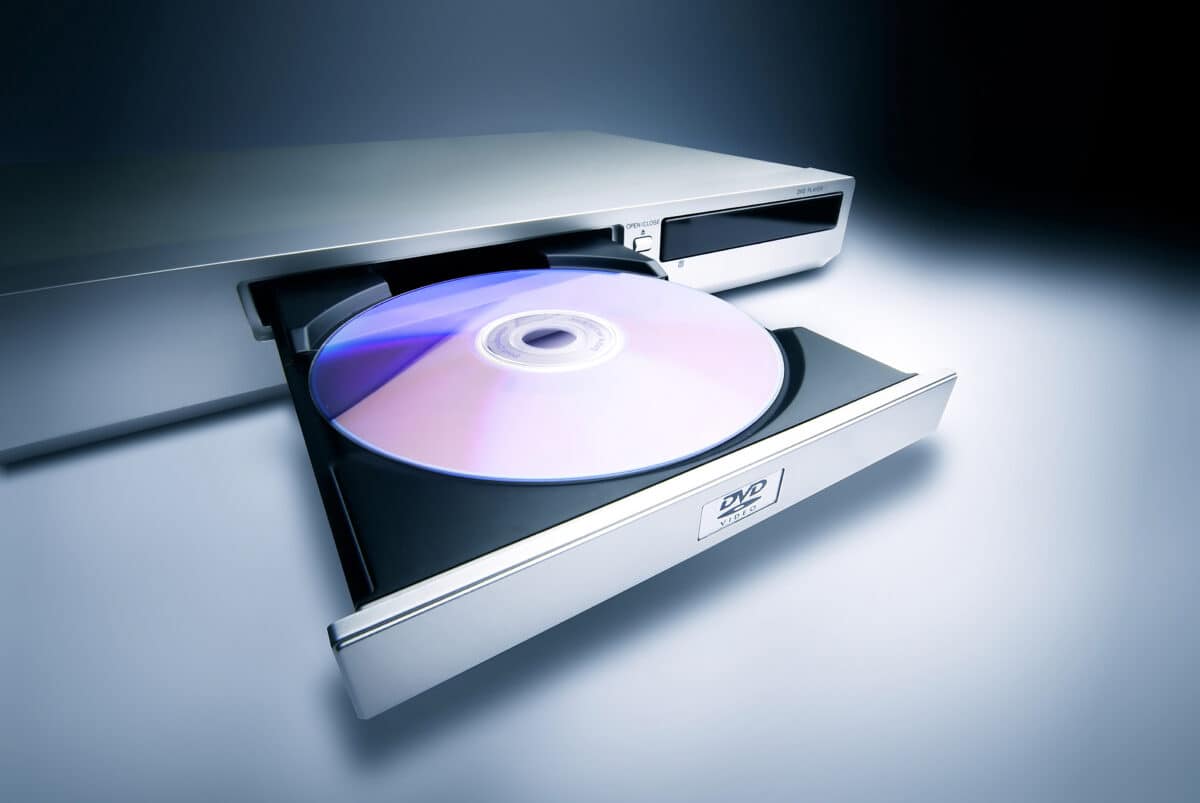Home video formats have seen plenty of heated battles since becoming popular in the second half of the 20th century. From film reels and VHS tapes to DVDs, the path that physical media has taken is paved with countless fallen formats along the way.
From Betamax tapes and gigantic LaserDiscs to HD DVDs, one new format typically ignites a heated battle between its rivals. Just look at the DVD vs Blu-ray battle of the late 2000s. Despite consistent sales for both formats, which of the two is truly the superior choice for home video?
In the age of streaming, some have decided to stick their nose up at physical media ownership. However, both DVD and Blu-ray have their own respective advantages. How can you tell which of these two home video formats is the best, though?
Let’s compare their specs side by side, then outline some additional key differences between DVD and Blu-ray. From there, we’ll examine their respective histories and their pros and cons in order to determine the overall winner. Let’s begin with the specs.
DVD vs Blu-ray: Side-by-Side Comparison
| DVD | Blu-ray | |
|---|---|---|
| First Released | November 1st, 1996 | June 20th, 2006 |
| Developer | Sony, Panasonic, Philips, Toshiba | Sony, Blu-ray Disc Association |
| Average Cost | $5-15 | $10-20 |
| Picture Quality | 480p | 1080p |
| Audio Quality | Dolby Digital, DTS | DTS:X, Dolby Atmos, DTS-HD Master Audio, Dolby TrueHD |
| Storage Space | 4.7-17.08 GB | 25-128 GB |
| Successor | Blu-ray disc | 4K UHD disc |
DVD vs Blu-ray: What’s the Difference?
While the above comparison of DVD vs Blu-ray specs is certainly helpful, it’s just as useful to lay out some of the most essential differences between the two home video formats. Across these differing specs, the three that matter the most are as follows: the format’s picture quality, the availability of bonus features, and the actual price of a movie in each format.
Let’s break down these key differences between DVD and Blu-ray below.
Picture Quality

©IM_photo/Shutterstock.com
A DVD’s picture quality depends on when and where it was first released; not to mention the quality of the actual film. Typically, the picture quality will range anywhere from 360p to 480p. Early on, many DVDs looked worse than this because they were “panned and scanned.”
In other words, they were ripped from VHS tapes and converted to DVDs. During the process, the quality of the picture wasn’t adjusted or cleaned up via traditional means of restoration. These days, with 4K TVs capable of upscaling, a DVD can look better than 480p. Still, it’s always going to be limited to standard definition by design.
Blu-rays, on the other hand, far exceed the picture quality of a DVD, even an upscaled one. At the very worst, your Blu-ray will be 720p. That’s still far superior to even the best DVD quality. At the very best, your Blu-ray will be 1080p — that’s even better, at twice the greatest DVD quality of 480p.
With the advent of 4K UHD Blu-rays, which reach quality standards upward of 2160p, there’s just no other way to put it; a Blu-ray’s picture quality is and always will be discernibly better than a DVD every single time.
Bonus Features
In the age of streaming, bonus features are one of the leading reasons to purchase a physical copy of a movie. It’s one of several aspects of physical media ownership you just can’t find on even the best-streaming sites (except The Criterion Channel and other boutique streamers, that is).
With this in mind, consider the current state of bonus features on the latest DVD releases. They’re practically non-existent. While older DVDs will likely be littered with more bonus features than your average contemporary Blu-ray release, DVDs in the 2020s are devoid of bonus features.
Blu-rays, on the other hand, can handle far more bonus features than a DVD. This is thanks to the increased storage capacity of a Blu-ray disc over a DVD. However, bonus features as an industry have been on the decline as streaming continues to grow more and more dominant.
Because Netflix and the like are disinterested in them, some producers don’t see a need for them at all. It’s weird; Blu-rays can and, in the past, have handled a far superior amount of bonus features. However, Blu-rays in the 2020s have been known to lack even so much as a commentary track.
Price
Lastly — and, for some, most importantly — there’s the price. Not just the price of a movie on the format itself, but the price of the whole setup required to actually watch it at home. As to be expected, considering it’s a 25-year-old format, a new DVD costs less than a new Blu-ray.
The margin is slim — typically around $5 or so, give or take — but it’s nonetheless there. DVD players are also much cheaper than Blu-ray players, coming in at around $20. Without the need for an HD TV, you can get a DVD-capable TV for less than $100, as well.
Blu-rays are a different story. Averaging around $20 a disc (or $25-$30, if you’re talking a 4K UHD Blu-ray), movies on Blu-ray cost more than movies on DVD. Sure, you’re paying for superior picture quality, but this doesn’t matter to every moviegoer.
Blu-ray players also cost markedly more than a DVD player, with cheaper models coming in at around $50-$75. HD TVs will run you about $100-$300, as well. It’s a much greater investment than the one required to play DVDs. However, it’s worth it for that image quality alone.
The History of the DVD
The invention of the DVD came after a long line of tinkering and experimenting, dating all the way back to the 1980s with the Video CD. Developed in 1995 and officially released in 1996, the DVD — or Digital Video Disc, or Digital Versatile Disc, depending on who you ask — offers the same physical dimensions of a compact disc (CD), with far more digital storage space.
Capable of storing all varieties of digital data, DVDs are primarily used for video, software, and large computer files. Total storage space on a DVD ranges anywhere from the standard 4.7 GB to a maximum of over 17 GB.
While initially pitted against the immensely popular VHS format, the DVD’s digital storage capabilities quickly allowed it to take precedence over the now-archaic magnetic tape. Warner Home Video was the first major studio to fully embrace the DVD toward the tail end of the 1990s.
It tested the waters with just four titles before expanding its library far and wide in the years that followed. Soon, other home video companies followed suit. By the summer of 1997, mass production was in full swing — both for DVD players and DVD discs.
As VHS slowly but surely faded from the forefront, DVD commanded a strong lead in the home video market. DVDs officially outsold VHS tapes for the first time in 2001, and by 2007, over 80% of U.S. households had a DVD player.
Surprisingly, DVD still reigns supreme today — even in the face of Blu-ray discs and 4K UHD discs. As recently as 2020, the DVD has held onto a 60% market share in the physical media sphere. That’s more than both Blu-ray and 4K UHD discs combined. More than 25 years since its inception, even superior picture quality cannot topple the DVD’s hold.
The Rise of the Blu-ray

©Singha Songsak P/Shutterstock.com
While these unmatched sales figures might suggest a winner in the DVD vs Blu-ray war, the truth is that this showdown is about more than just price and profit. The Blu-ray was first developed in 2005, just a decade after the inception of the DVD.
Intended to serve as the natural successor for the DVD, the Blu-ray came equipped with 720p-1080p video storage capabilities — as much as two to three times the picture quality of a DVD. Synonymous with the idea of high-definition home video, the Blu-ray is also the preferred storage method for the latest and greatest current-gen video games.
The Blu-ray came about for more reasons than just picture quality. After the DVD gained popularity for its red laser and red wavelength storage, the developers of the Blu-ray discovered that violet lasers and violet wavelengths could store far more.
Sony immediately leaped at the opportunity to be the developer of the DVD’s successor which, at the time, was selling remarkably well. Try $16.3 billion in DVD sales for 2005 alone. The first commercially viable Blu-ray discs and Blu-ray players were ready for stores by the summer of 2006.
By June 2008, more than 3,500 films had been released on Blu-ray in the U.S. Still, DVDs continued to sell far better than Blu-ray in spite of their superior quality. Whether it was the increased price of the Blu-ray, the slow adoption of HD TVs, or the simple fact that most of what was available on Blu-ray was also available on DVD, a strange phenomenon was occurring.
Namely, the DVD vs Blu-ray war seemingly came to a tie. Both Blu-rays and DVDs continue to be released side by side today, with neither showing signs of stopping.
DVD vs Blu-ray: Pros and Cons
| Pros of DVD | Cons of DVD |
|---|---|
| More affordable than Blu-ray | Worse picture quality compared to Blu-ray |
| Still selling better than Blu-ray and 4K UHD | Lower audio quality in comparison to Blu-ray |
| Older films are mostly available on DVD | Older format than Blu-ray |
| DVDs have a cheaper home theater setup | Lacks scratch resistance |
| Pros of Blu-ray | Cons of Blu-ray |
|---|---|
| Higher picture quality compared to DVD | More expensive than a DVD |
| Superior audio quality | Lacks the number of older titles available on DVD |
| More storage than DVD | Lower quality than a 4K UHD disc |
| Scratch-resistant coating on discs | HD setup costs more |
DVD vs Blu-ray: 5 Must-Know Facts
- DVDs are the standard for SD video, while Blu-rays are the standard for HD video. These formats are mutually exclusive, as DVDs will never be high-definition and Blu-rays will never be standard-definition.
- Home video sales continue to drop year after year. In 2019, sales amounted to $3.29 billion. In 2020, $2.45 billion. In 2021, just $1.97 billion. Compare this to 2005, when sales hit a peak of $16.3 billion.
- Today, the market is split about 50/50. Blu-rays and 4K UHD discs make up one-half of the market share, and DVDs account for the other 50% of physical media sales.
- Most home video format wars — such as VHS vs Betamax and LaserDisc vs DVD — result in a winner and a loser. However, with DVD and Blu-ray, the two have essentially reached a tie. Both formats co-exist decades after their respective launches.
- DVDs are plagued by scratched discs, while Blu-Ray discs are covered in a scratch-resistant coating.
DVD vs Blu-ray: Which One Is Better?
Despite DVD boasting more older titles and coming in at a lower price point compared to the Blu-ray, there’s just no denying the fact that Blu-ray is superior to DVD in nearly every other way. DVD vs Blu-ray quality? Blu-ray triumphs both audibly and visually.
DVD vs Blu-ray bonus features? Again, Blu-ray comes out on top with far more bonus features for new releases. You’re going to have to spend more money to get a proper Blu-ray setup, to be sure, but it’s all going to be worth it for that drastically superior quality.
Even if you’re a streaming loyalist, there’s still much greater appeal for Blu-ray above all else. With more titles available on Blu-ray than streaming, better picture quality than streaming, and more accessibility than streaming, Blu-ray comes out on top again and again.
It might seem like DVD and Blu-ray are evenly matched because both are still produced and sold, but make no mistake. Blu-ray is the better home video format by a long shot.
The image featured at the top of this post is ©Cyrustr/Shutterstock.com.






